ASRock Rack ROMED8-2T Block Diagram
We wanted to take a moment and look at the ASRock Rack block diagram for this platform because it is something to behold.
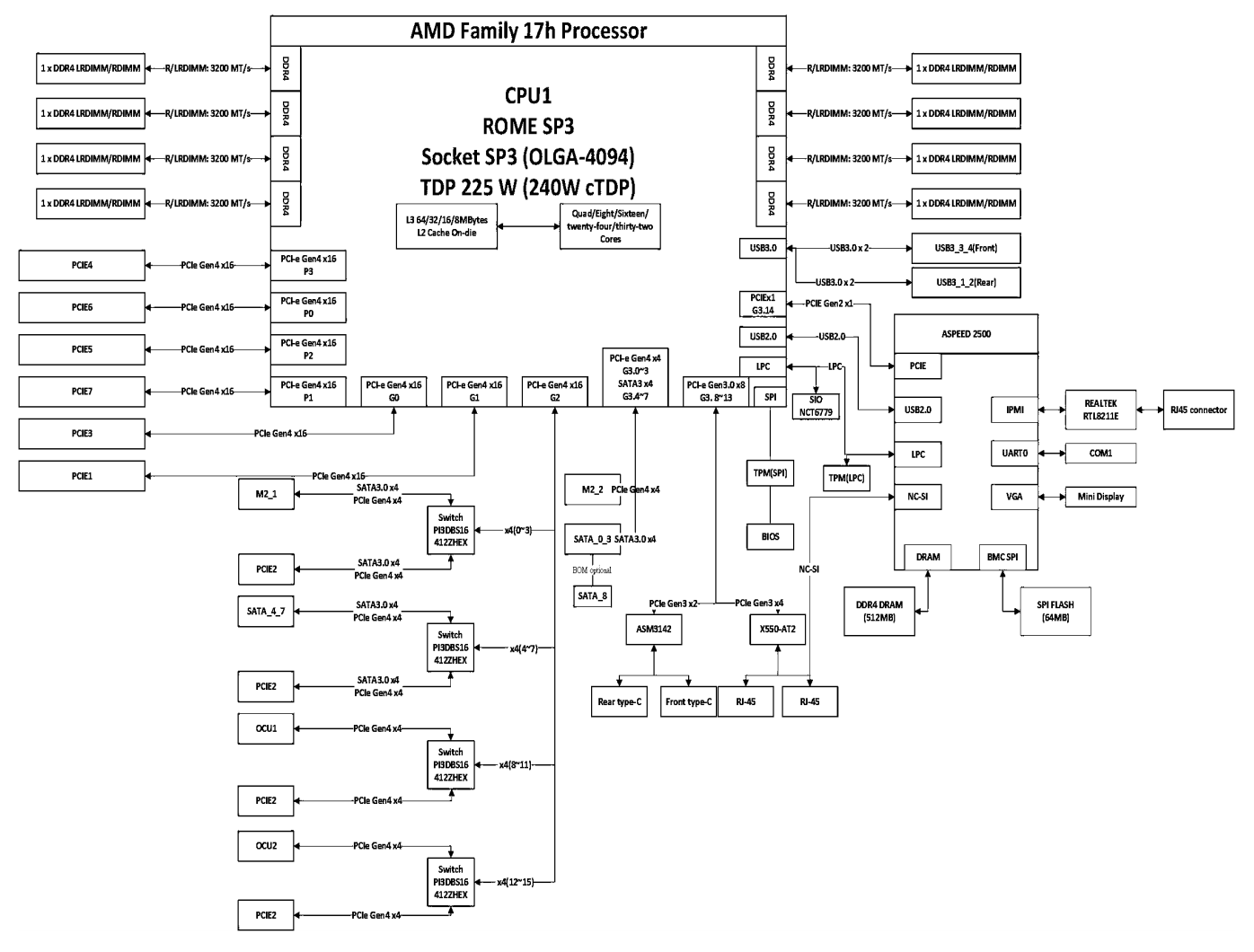
In the center is the AMD EPYC CPU with the top occupied by the 8x DDR4-3200 channels. The bottom right of the diagram has the BMC (ASPEED AST2500) and all of the functionality around that.
Virtually the entire bottom and part of the left side of the diagram are dominated by PCIe lanes. Six of the eight PCIe Gen4 x16 lane sets coming from the CPU are simple to understand. They go directly to PCIe slots. The remaining two have an enormous amount going on in the block diagram.
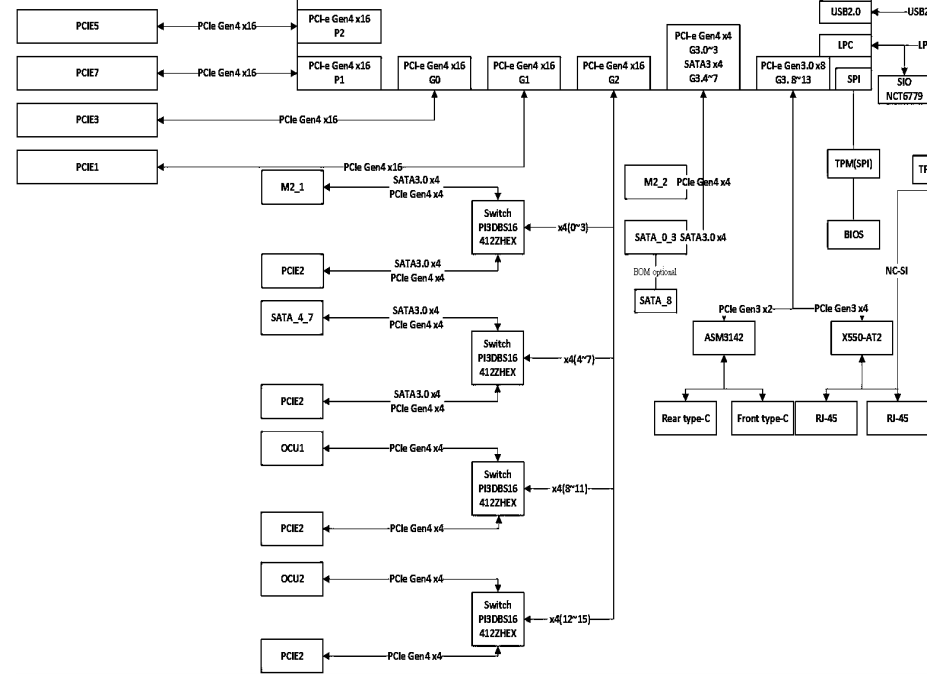
We discussed how ASRock Rack is using the flexible I/O controller of the AMD EPYC I/O lanes to divert PCIe lanes to various functions such as M.2, miniSASHD (SATA) and Oculink ports. There are two jumpers on the bottom of the motherboard that handles a lot of the switching you see above on the block diagram.
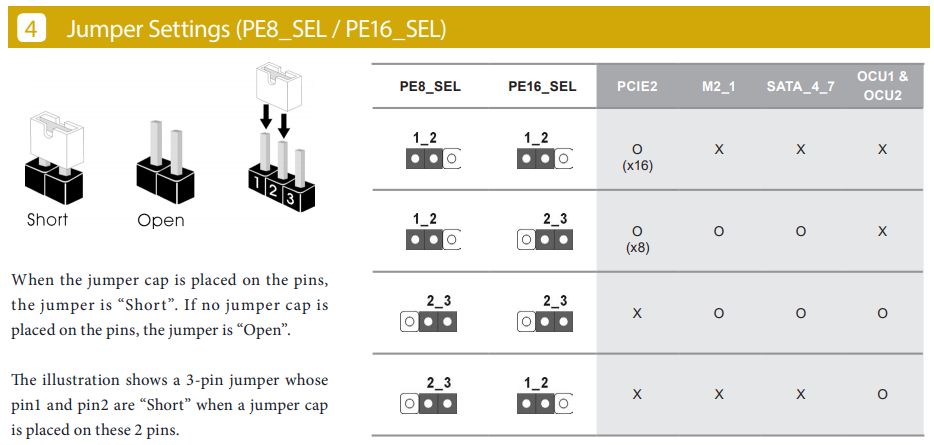
For those of us old enough to remember when a normal part of setting up a motherboard was making sure all of the jumpers were aligned, this will seem familiar. Still, most motherboards these days do not have jumper arrays that need to be set to use different ports. Again, as you can see from the block diagram, this is necessary since ASRock is exposing so much functionality to the motherboard. Still, we want our readers to be aware so they do not try plugging a device in, find it not working, only to realize they just need to change a jumper setting.
Final Words
Make no mistake, the ASRock Rack ROMED8-2T delivers on the “wow factor” of packing an almost unthinkable amount of PCIe I/O in such a small form factor. It also shows a very good reason why we are going to see more cabled PCIe solutions as we move further into the PCIe Gen4 and Gen5 era. As PCIe lane counts increase, and in a few years technology like CXL comes into the market, it will start making sense to disaggregate slots to make designs more flexible.
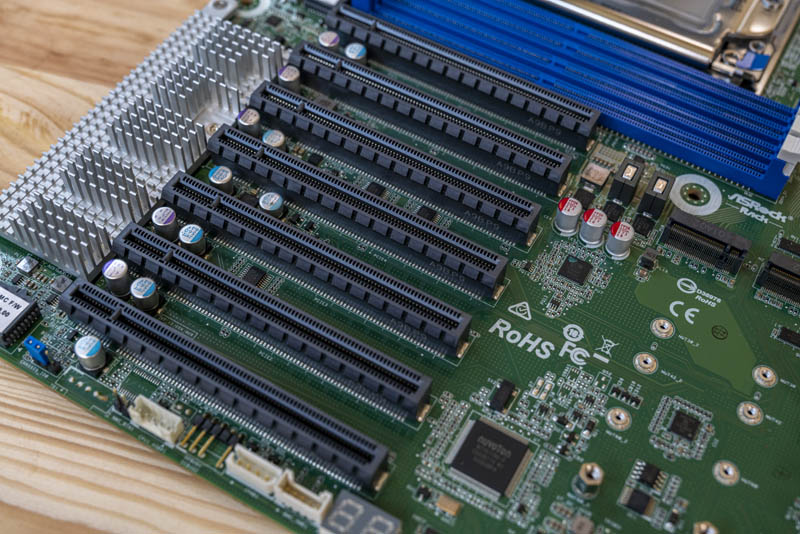
With the ROMED8-2T one can, relatively affordably, get 64-cores, 128 threads, and high memory capacity into an ATX form factor while still utilizing the huge number of PCIe Gen4 lanes. It is strange to think about it in this manner, but the ROMED8-2T is a relatively compact platform that can rival dual or quad Intel Xeon solutions in terms of cores and connectivity. While normally one would pay a steep premium for this compactness, in this case one can get it at a very reasonable price. The motherboard retails in the $650-700 so it is a premium motherboard. For that price, one gets the ultimate flexibility. We like that ASRock Rack also went the extra step in adding small features to the platform such as USB Type-C ports and dual 10Gbase-T networking instead of simple 1GbE.
Overall, the ASRock Rack ROMED8-2T offers superior flexibility and expandability while simultaneously fitting all of that functionality into an ATX form factor that has decades worth of chassis engineering behind it.



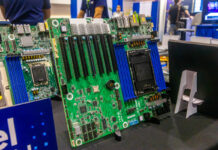
Patrick,
Is the ASRock Rack ROMED6U-2L2T slated for review at some point?
We have a couple on the way here shortly as Micro-ATX is perfect for a small cluster node application.
Thanks for the great articles. It’s great to see objectivity like this as it builds trust. :)
Philip
Just started coming to this site regularly since I put a rack in my basement. Really like the content!
Anyone have power consumption numbers for this board with a low-end EPYC chip? I want something I could load up with RAM, but not something that idles at 100+ watts.
On the AsRockRack website are CPUs with over 225W TDP listed in the supported CPU list. Are they compatible or just with extra airflow over the VRMs? What’s correct?
i would like to know 2 things:
– case used to house the board ? is it server rack case, used with air shrouder ??
– how hot get CPUVRM when cpu is fully loaded at all cores ??
I think there is a one small problem – and it’s with the name of this motherboard.
ASRock Rack has already a motherboard named ROMED8-2T, and it has 4 PCIe 3.0 X16 and 3 PCIe 3.0 X8 and it’s for both ROME and Naples CPU’s (7001 & 7002 series).
This board has the same name, and it’s a pity that they didn’t change it, so if you plan to buy this board, then MAKE SURE you’ll getting this one and not the older one.
Oops, my bad. The previous gen called EPYC8D-2T, and this is ROME8D-2T. Terrible names!
Patrick,
You mention that this MB only support 1 DIMM per channel, but you don’t have any test which compare memory performance against ‘standard’ server MBs.
Perhaps you could post an update with a comparison?
hi there,
thanks for the great review! I bought this board few weeks ago and there is one big trouble currently: neither bios nor ipmi lets me configure fan controls. Talked tomasrock already, they promised new firmware until, well, yesterday. now they told me it is going to be tuesday, we will see. right now all fans run at full speed and dont make use of any thermal management.
did you guys experience something alike?
cheers
How does this compare to Tyan Tomcat HX S8030 (S8030GM4NE-2T)? Thanks!
As the first person in Europe who got this board more than 2 months ago. Have to say I’m not super impressed. The fact they advertise Thunderbolt support and there is a TB header on the notherboard but it does not work at all and I made AsrockRack aware of this months ago and they seem to try and suppress this glaring issue. (I also have TRX40 Creator where they advertised Thunderbolt support but then removed it from website and BIOS (i still have the BIOS that contains a whole optuons page with Thunderbolt options.)
Have to say I have been very disappointed by Asrock lately, and I used to be a hughe fan.
I don’t see thunderbolt on their site for this or in the review. It’s an AMD platform so i wouldn’t expect it to have TB support. Intel has only certified a very small set of AMD for TB right?
So they also removed it from their website now which reinforces my point. I have the printed manual that came with the motherboard that states TB support and also with all respect I have the motherboard in my hand You don’t. Why would Asrock go through all the trouble and implement a physical header on the motherboard and in the BIOS named Thunderbolt and then try to.erase it from the website?! Time for my EU commisary to investigate.
I always get asrock if possible for any build, and they again show they are on top with their Motherboards, propped full of features pushing the limits of all the form factors. Hope to see the 2p ROME2D16-2T next!
Any case suggestions ?
I am planning to plug 7 watercooled gpu on it.
Thanks for the review. When I build my next system it will be with this motherboard. My own AI workstation.
@Mario I am also facing the same problem, that there does not seem to be any fan control in either bios or ipmi…..
For now plugging them to PSU, but thats one loud box now…
Do you have access to linux drivers, firmware or an updated BIOS for this board? BIOS P1.10 sees the one SATA drive, the Boot menu sees the SATA drive, Windows sees the SATA drive, but Debian does not. I use Debian 10 (Buster) stable with kernel 5.6 from backports with linux-firmware (including non-free). Everything, including Debian, sees and installs on the two nvme sticks on the motherboard.
Does anyone know if we solder the TB header will that work? Any setting in the BIOS?
Probably a stupid question but I’ll ask anyway. With Zen three coming out, will this board be compatible or should I be patient and wait? Really want to set it up with Milan!
Also, with 8 dimm channels, would I benefit from filling all slots and dispersing the memory in say, 128gb segments at 1tb vs 4 256gb ram? Cost prohibitive!
I have this motherboard and after 2 months one of the 10gb ethernet ports went out (totally dead – no lights etc even though driver still sees port). Asrock won’t do a cross-ship which means I’m down for weeks on my server. I stuck an Intel X520 card I had in to cover me and am now debating what to do. Sort of disappointed in Asrock for not offering to cross-ship a $600 motherboard and wondering if quality control is not up to snuff. This was my first venture away from Supermicro and I’m regretting it.
Hello Longreen – Do you know what BIOS version has Thunderbolt in it? Is it still on the latest version but not working?
Interesting update on this board that it now support the 7003 processors (with BIOS update)
https://www.asrockrack.com/general/productdetail.asp?Model=ROMED8-2T/BCM#Specifications
Has anyone got Esxi 8 running on the ASRock ROMED8-2T? I`m hoping to run 8.0U1 on this as a homelab machine with a cheap epyc 7302p from Ebay
I live in the UK so if you have any better suggestions I would be interested if there were a better alternative?